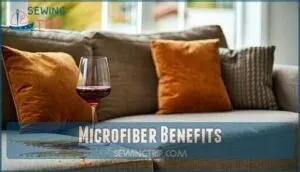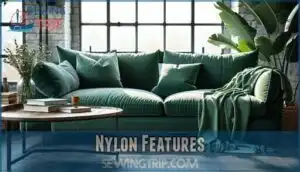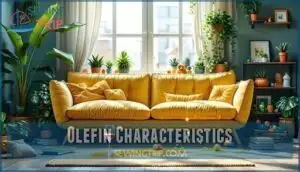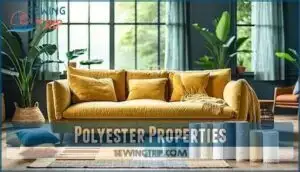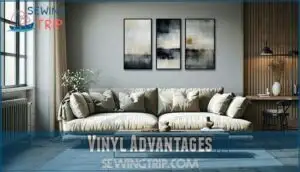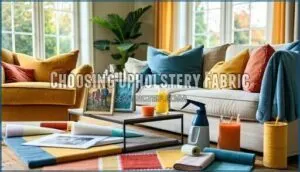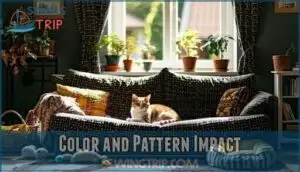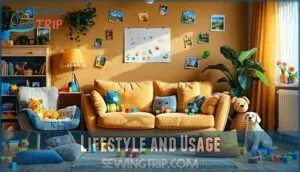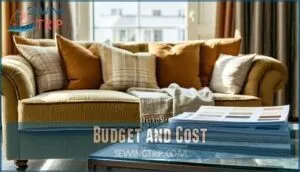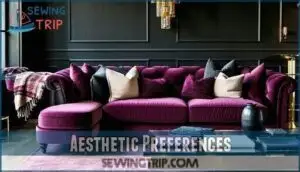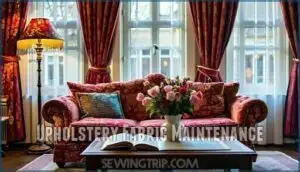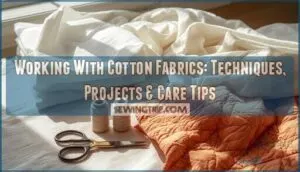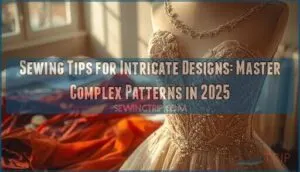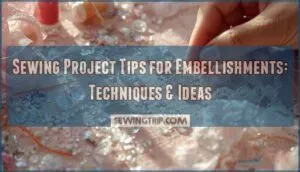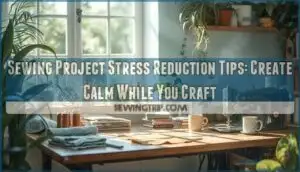This site is supported by our readers. We may earn a commission, at no cost to you, if you purchase through links.
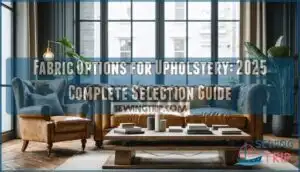 You’ve got amazing fabric options for upholstery that’ll transform your furniture while fitting your lifestyle.
You’ve got amazing fabric options for upholstery that’ll transform your furniture while fitting your lifestyle.
Natural fabrics like cotton and linen offer breathability and classic appeal, while leather brings durability and luxury.
Synthetic options including microfiber and polyester deliver superior stain resistance – perfect for busy households with kids or pets.
Consider your home’s traffic patterns: high-use areas need tough performers like vinyl or treated fabrics, while formal spaces can showcase delicate silks or wools.
Your choice depends on maintenance preferences, budget, and whether you’re dealing with muddy paws or spilled juice boxes. The secret lies in matching fabric properties to your specific needs.
Table Of Contents
Key Takeaways
- Match fabric to your lifestyle – Choose microfiber or polyester blends if you’ve got kids and pets, since they resist stains and scratches, while leather works great for easy cleanup in high-traffic areas.
- Consider durability over looks – Synthetic fabrics, such as olefin and treated polyester, handle daily wear better than natural options, lasting longer in busy households, despite potentially higher upfront costs.
- Factor in maintenance requirements – You’ll save time with synthetic fabrics that need simple vacuuming and wiping, while natural fabrics, like cotton and linen, require more careful cleaning and professional treatment.
- Don’t ignore pattern and color strategy – Dark colors and busy patterns hide pet hair, scratches, and stains effectively, making your furniture look better longer, with less visible wear.
Natural Fabric Options
When you’re selecting upholstery for furniture that’ll see daily use, natural fabrics offer breathability and comfort that synthetic materials can’t match.
Natural fabrics breathe with your lifestyle while synthetic options power through daily chaos.
These time-tested materials bring unique characteristics to your furniture, from cotton’s versatility to leather’s durability, making them excellent choices for creating comfortable living spaces.
Cotton Characteristics
Cotton stands as the most popular choice for upholstery projects because it delivers exceptional Cotton Durability while maintaining superior Fabric Breathability.
You’ll appreciate how this natural fiber resists pilling and fading, making it perfect for pet owners who need reliable textile characteristics.
Cotton’s versatility shines through various cotton fabric options, from casual weaves to formal blends.
However, Cotton Care requires attention since untreated cotton fabrics stain easily without protective treatments.
Linen Features
With its distinctive linen texture and loose fabric weave from the flax plant, linen upholstery fabric offers unmatched breathability that keeps your pet cool during hot summer months.
This natural fiber’s relaxed thread count creates an elegant, lived-in look perfect for casual spaces.
- Natural breathability: Linen weave allows air circulation, preventing pet overheating
- Wrinkle-friendly appearance: Natural creases add character without looking messy
- Lightweight comfort: Natural fibers provide softness without bulk for pet relaxation
Silk Properties
Luxury fabrics like silk upholstery materials bring unmatched elegance to your furniture, but they come with trade-offs.
Silk’s delicate nature means you’ll need professional cleaning and careful maintenance to preserve its lustrous fabric texture.
The textile strength varies substantially based on fabric weaving techniques and silk finishing processes.
While silk durability can’t match synthetic options, these luxurious materials create stunning statement pieces when properly cared for in low-traffic areas.
Wool Benefits
Wool delivers unmatched fiber strength and natural insulation for your furniture.
This breathable fabric resists pilling, fading, and stains while maintaining its shape through daily wear.
You’ll find wool fabric choices blend beautifully with synthetic fibers, creating eco friendly fabric options that handle pet hair and scratches.
Its natural durability makes wool perfect for high-traffic areas.
Choosing sustainable fabrics involves considering eco friendly materials to reduce environmental impact, which is a key aspect of using natural materials.
Leather Advantages
Leather upholstery fabric transforms your furniture into a pet-friendly powerhouse that laughs in the face of daily chaos.
You’ll appreciate leather’s durability against scratches while its easy-care nature means you can quickly wipe away muddy paw prints.
Quality leather finishes resist stains better than most fabrics, and various leather styles complement any décor from rustic to modern, making it a great choice for a powerhouse of daily activity.
Synthetic Fabric Types
When you’re looking for upholstery fabrics that can handle daily wear and tear, synthetic options deliver impressive durability and easy maintenance.
These engineered materials resist stains, fading, and moisture better than most natural fabrics, making them perfect for busy households with pets and children, due to their easy maintenance.
Microfiber Benefits
Microfiber fabric options deliver exceptional performance for pet owners seeking hassle-free upholstery solutions.
Perfect for busy pet owners who demand performance without the fuss.
Its tightly woven synthetic fibers create a durable surface that withstands daily wear while maintaining softness and comfort.
Here are three key microfiber advantages:
- Microfiber Durability – Resists deterioration from sunlight, water, and insects while retaining its original texture through years of heavy use
- Stain Resistance – Water repellent fabric naturally repels spills, allowing liquids to bead up for quick cleanup without penetration
- Easy Cleaning – Low maintenance requirements mean simple vacuuming and occasional wiping keep your furniture looking fresh
The benefits of using microfiber include its resistance to stains and fade, making it a great option for microfiber upholstery.
Nylon Features
Nylon strength makes this synthetic powerhouse a top choice for upholstery fabric options.
You’ll find nylon woven into fabric blends, boosting durability where pure natural fibers might fail.
Its industrial uses prove its toughness – if it handles factory conditions, your sofa’s a breeze.
Synthetic materials like nylon resist soiling and wrinkling better than cotton or linen.
Textile science shows nylon’s resilience keeps microfiber fabric options performing longer in high-traffic homes, due to its synthetic properties.
Olefin Characteristics
Olefin stands out among synthetic fabrics for its exceptional resistance to stains, mildew, abrasion, and sunlight damage.
You’ll find this fabric performs incredibly well in high-traffic areas where spills happen frequently.
Its color fastness means your furniture won’t fade even with direct sun exposure.
The fabric’s strength makes it nearly indestructible against daily wear and tear, while its stain resistance keeps maintenance simple.
Polyester Properties
Polyester stands out among synthetic fabrics for its remarkable versatility and performance.
You’ll find polyester fabric options that resist wrinkling, fading, and stretching while maintaining vibrant colors year after year.
This fabric durability makes polyester ideal for high-traffic furniture that needs to look fresh despite daily use.
Fabric blends combining polyester with natural fibers offer enhanced stain resistance and improved texture variety, giving you freedom to choose from countless synthetic fabric properties without sacrificing style, which is a key aspect of its overall performance.
Vinyl Advantages
You’ll find vinyl upholstery fabric offers unmatched practicality for busy households.
This faux leather fabric delivers exceptional vinyl durability while remaining budget-friendly compared to genuine leather.
Easy cleaning becomes effortless—simply wipe spills away with a damp cloth.
Low maintenance requirements make vinyl perfect for high-traffic areas.
Modern vinyl costs substantially less than leather alternatives while providing impressive stain resistant fabric properties and fire retardant fabric safety features.
When selecting vinyl, consider the various fabric types options to guarantee the best choice for your specific needs.
Choosing Upholstery Fabric
Selecting the right upholstery fabric requires balancing durability, maintenance, and your family’s specific needs.
You’ll want to take into account factors like stain resistance, scratch protection, and cleaning requirements before making your final choice.
Durability Considerations
When you’re choosing upholstery fabric, durability isn’t just about looking good—it’s about surviving real life.
Look for fabrics with high double rub counts (15,000+ for residential use) to measure abrasion resistance.
Fabric testing reveals tear strength and wear resistance, while pilling resistance keeps surfaces smooth.
Consider fabric longevity over initial cost, since quality materials outlast cheaper alternatives that’ll need replacing sooner.
Stain Resistance
When dealing with pets and daily spills, stain resistance becomes your upholstery’s first line of defense.
Revolution fabrics use solution-dyed olefin fibers that repel stains naturally, while Crypton technology creates permanent barriers against moisture and odors.
Water resistance and oil repellent treatments protect against accidents, making stain removal simple with basic cleaning products.
For more information on durable options, consider stain resistant fabrics that can withstand heavy use, providing a permanent barrier against moisture and odors with solution-dyed olefin fibers.
Maintenance Requirements
Regular fabric care determines how long your upholstery lasts and looks great.
You’ll need different maintenance schedules based on fabric type – leather requires conditioning every six months while microfiber needs weekly vacuuming.
Most fabrics benefit from professional cleaning annually, but high-traffic pieces may need it twice yearly.
Simple stain removal techniques and consistent upholstery repair prevent minor issues from becoming costly replacements, which is crucial for upholstery care and involves professional cleaning.
Homes With Kids
Little ones turn your furniture into obstacle courses daily.
Microfiber emerges as your champion with its washable fabrics and superior stain resistance.
Patterned upholstery cleverly camouflages juice spills and crayon marks.
Durable weaves withstand jumping sessions while budget-friendly choices like polyester blends offer family-friendly fabrics.
Consider performance textiles for playroom furniture where wear resistance matters most.
Pet-Friendly Options
When living with pets, you’ll need upholstery fabric that withstands daily challenges while maintaining comfort.
Pet-friendly fabrics combine durability with practical features that make life easier for both you and your furry companions.
Here are 5 essential pet-friendly fabric features:
- Scratch Resistance – Tightly woven microfiber and leather resist claw damage
- Hair Resistance – Smooth synthetic surfaces release pet hair easily during cleaning
- Odor Control – Performance fabrics with antimicrobial treatments prevent lingering smells
- Stain Resistance – Treated polyester blends repel accidents and spills effectively
- Paw Cleaning – Non-porous materials wipe clean without absorbing dirt or moisture
Choose microfiber, polyester blends, or genuine leather for ideal pet-friendly and family-friendly performance.
These upholstery fabrics offer superior wear resistance while addressing allergy concerns through easy maintenance routines.
Fabric Selection Criteria
Selecting the right upholstery fabric requires balancing multiple factors that directly impact your furniture’s performance and longevity.
You’ll need to evaluate how color choices, lifestyle demands, budget constraints, environmental conditions, and personal style preferences work together to guide your decision, considering complete concepts that affect your choice.
Color and Pattern Impact
Color and pattern choices transform your space from ordinary to extraordinary.
Dark shades and busy patterns excel at stain camouflage, making pet accidents vanish like magic. Pattern scale affects visual space – large prints shrink rooms while small designs expand them. Color psychology influences mood, with calming blues reducing pet anxiety and energizing reds boosting activity.
| Color/Pattern Choice | Pet-Friendly Impact |
|---|---|
| Dark colors + geometric patterns | Hide scratches, fur, and stains effectively |
| Textured fabrics with variations | Camouflage wear patterns and claw marks |
| Multi-tonal designs | Create visual interest while masking imperfections |
| Coordinated earth tones | Blend with natural pet colors for seamless look |
Smart fabric coordination considers both aesthetic appeal and practicality, ensuring your furniture maintains visual interest despite daily pet challenges.
Lifestyle and Usage
Your daily routine shapes your fabric choice more than you’d think.
Busy households with kids running around need fabrics that can handle spills and constant use. Pet owners require scratch-resistant materials that won’t show fur or claw marks.
Consider these lifestyle factors:
- High traffic areas demand heavyweight fabrics with stainresistant finishes for longevity
- Family needs drive choices toward familyfriendly fabrics like microfiber and treated polyester blends
- Daily wear patterns determine whether you need easy-clean surfaces or can maintain delicate materials.
Petfriendly fabrics with excellent fabric durability reduce fabric maintenance headaches.
Budget and Cost
Your upholstery budget shapes every fabric decision you’ll make.
Cotton offers the most wallet-friendly starting point at $30 per metre, while luxury silk commands $85-124 per metre.
Smart cost savings come from comparison shopping online and timing purchases with seasonal sales.
Polyester blends deliver excellent cost-effective durability for families.
Remember that fabric prices represent just one piece – labor adds $2,300-4,000 for sofas, making fabric affordability essential for total budget planning.
Environmental Factors
Temperature fluctuations affect fabric durability and performance.
You’ll face challenges from humidity, sunlight exposure, and seasonal changes that impact material longevity.
Sustainable materials like eco friendly fabric options resist climate change effects better than traditional choices.
Indoor air quality improves with sustainable sourcing practices and green cleaning methods.
Natural fibers handle environmental stress differently than synthetics, requiring consideration of your home’s specific conditions and carbon footprint goals.
When selecting upholstery fabrics, considering sustainable fabric options can substantially reduce environmental impact.
Aesthetic Preferences
Your personal style matters just as much as practical considerations when selecting upholstery fabric.
While functionality guides your initial choices, aesthetic preferences transform your furniture into a true reflection of your taste and personality.
- Texture Options: Smooth leather creates sleek modern vibes, while bouclé adds cozy warmth
- Color Schemes: Dark hues hide pet hair and stains better than light fabrics
- Pattern Choices: Bold prints can camouflage claw marks and everyday wear
- Fabric Styles: Velvet brings luxury, while linen offers casual elegance
- Design Trends: Current favorites include performance fabrics in rich jewel tones
Upholstery Fabric Maintenance
Once you’ve selected the perfect upholstery fabric, proper maintenance becomes your furniture’s lifeline for lasting beauty and durability.
You’ll need to establish cleaning routines, master stain removal techniques, and protect your investment from daily wear and pet-related challenges, which is crucial for the durability of your furniture.
Cleaning and Care
Proper fabric cleaning transforms your upholstery from worn to wonderful.
Regular vacuuming prevents dirt buildup while spot cleaning tackles fresh spills immediately.
Check cleaning codes before applying products—"W" means water-based cleaners work, while "S" requires solvents.
Weekly maintenance schedules keep fabric care manageable.
Use fabric protectors after deep cleaning to boost stain resistance and extend lifespan.
Understanding delicate fabric care is essential for maintaining the quality and appearance of upholstery fabrics, and following a weekly maintenance schedule is crucial.
Stain Removal Techniques
When stains inevitably happen, quick action saves your furniture from permanent damage.
Use the wet method for most spills by gently dabbing with appropriate cleaning solutions like dish soap mixed with water.
For delicate fabrics, try natural alternatives like white vinegar or baking soda.
The dry method works best for certain materials—let the area dry completely before brushing away residue.
Always test cleaning products on hidden areas first to prevent fabric damage and ensure the cleaning solution is appropriate for the material, using methods like the wet or dry method.
Fabric Protection Methods
Applying fabric protectors transforms your upholstery from vulnerable to virtually bulletproof against life’s messiest moments.
Spray-on Scotchgard creates an invisible shield that repels liquids and prevents stains from penetrating fibers.
Waterproof coatings offer maximum protection for pet-prone areas, while UV protection prevents sun damage and fading.
Professional fabric treatments provide longer-lasting stain resistance than DIY options, making cleanup effortless when accidents happen, and using a fabric protector is essential for maintaining the quality and longevity of your upholstery, with maximum protection and effortless cleanup being key benefits.
Regular Maintenance Tips
Weekly vacuuming removes pet hair and debris that damages fabric fibers over time.
You’ll want to use upholstery attachments for deeper cleaning between cushions where crumbs hide. Rotate cushions monthly to prevent uneven wear patterns.
Address spills immediately with blotting motions – rubbing pushes stains deeper into fibers.
These simple fabric care tips maintain your upholstery’s appearance and extend fabric durability ratings substantially, ensuring a longer life for your upholstery.
Professional Cleaning Services
When deep cleaning becomes overwhelming, professional upholstery cleaning services break the chains of stubborn stains and persistent odors.
Expert technicians use advanced disinfection methods and fabric sanitizing equipment to restore your furniture’s glory.
They’ll tackle what your vacuum can’t reach, applying specialized stain removal techniques and fabric protectors that extend your upholstery’s lifespan substantially, using equipment that provides persistent results.
Frequently Asked Questions (FAQs)
What kind of fabric is best for upholstery?
Like choosing armor for battle, selecting upholstery fabric requires strategic thinking.
For pet owners, microfiber and polyester blends offer unbeatable stain resistance and scratch protection, while leather provides easy cleanup for busy households with furry friends.
What is the best fabric for covering a couch?
Microfiber and leather reign supreme for couches. You’ll find microfiber resists stains and scratches while staying pet-friendly. Leather’s durability makes it perfect for high-traffic living rooms, aging gracefully with character.
What is the toughest upholstery fabric?
Looking at toughness requirements, olefin fabric delivers superior durability with exceptional resistance to stains, mildew, abrasion, and sunlight damage, making it your strongest choice for high-traffic upholstery applications.
What are the categories of upholstery fabric?
Upholstery fabrics fall into two main categories: natural and synthetic. Natural fabrics include cotton, linen, silk, wool, and leather. Synthetic options feature polyester, nylon, acrylic, microfiber, olefin, and vinyl.
How much fabric do I need for reupholstering?
Most DIY reupholstery projects fail due to inadequate fabric calculations.
You’ll typically need 3-8 yards depending on furniture size.
Measure each section carefully, add 10% extra for seams and mistakes, and account for pattern repeats when calculating total yardage requirements.
Can outdoor furniture fabrics be used indoors?
Yes, you can use outdoor furniture fabrics indoors.
They’re actually great choices because they’re engineered for durability, stain resistance, and moisture protection.
These performance fabrics handle spills, pets, and heavy use exceptionally well, making them a great option for indoor use due to their stain resistance.
Whats the difference between fabric weight grades?
Fabric weight determines how many ounces per square yard your material weighs.
Lightweight fabrics (under 12 oz) work for occasional-use pieces, while heavyweight options (over 16 oz) handle daily wear from pets and kids.
How do I match fabric patterns correctly?
Match patterns by aligning repeats at seams and measuring pattern intervals carefully.
Plan cuts to center motifs on prominent surfaces.
Use old fabric pieces as templates and mark grain direction consistently for professional results.
Which fabrics work best for antique furniture?
Looking to preserve your antique’s authentic charm?
Natural fabrics like wool, linen, and cotton blends work best for antique furniture restoration.
These materials match period-appropriate textures while offering durability and breathability that complement vintage construction methods, ensuring the preservation of the antique’s authentic charm.
Conclusion
Choosing fabric options for upholstery becomes your compass, guiding you through the vast terrain of interior design possibilities.
Your decision impacts daily life for years ahead, and natural fabrics bring timeless elegance but require more care, while synthetic options handle life’s messiest moments with grace.
Consider your household’s rhythm: children’s sticky fingers, pets’ muddy paws, and everyday wear patterns, as the perfect fabric balances beauty with practicality.
The perfect fabric matches your lifestyle’s demands while creating spaces you’ll love living in for years.
- https://malleryhall.com/best-upholstery-fabric-guide/
- https://www.decorativefabricsdirect.com/Upholstery-Fabric-For-Home-Decor-s/737.htm
- https://vntghome.com/journal/upholstery-demystified
- https://maake.com/blogs/upholstery/upholstery-fabrics-full-guide
- https://www.nafurniture.com/decoding-performance-fabrics-what-it-all-means/

